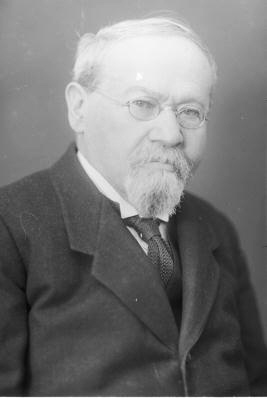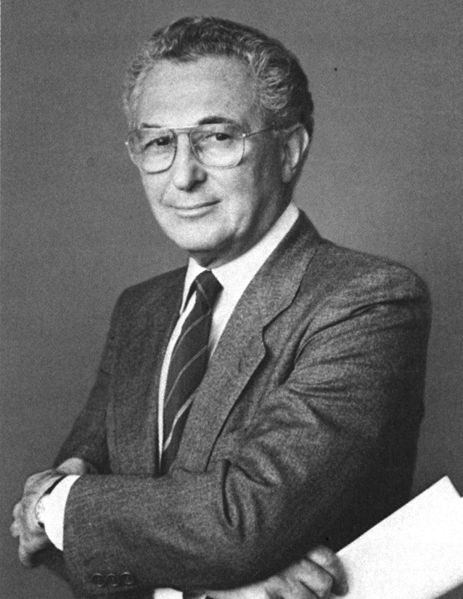<Back to Index>
- Dermatologist Salomon Ehrmann, 1854
- Dermatologist Norman Orentreich, 1922
PAGE SPONSOR

Salomon Ehrmann (December 19, 1854 - October 24, 1926) was a Jewish Austrian dermatologist and histologist who was born in the village of Ostrovec, which today is part of the Czech Republic. He was an important member of the so called Vienna School of Dermatology, which was originally founded by Ferdinand von Hebra (1816 – 1888).
Ehrmann was a pupil of histopathologist Carl Wedl (1815 – 1891) at the University of Vienna, and later became director of the dermatological department at Vienna General Hospital. He specialized in the field of syphilology, and is remembered for his research involving the parasite Spirochaetae pallida (the causative agent of syphilis), and its spread throughout the human body.
In 1895 he described acne keloidalis, which he referred to as folliculitis nuchae sclerotisans. Among his written works was a comparative diagnostic atlas of skin diseases called Vergleichend-diagnostischer Atlas der Hautkrankheiten und der Syphilide.
Norman Orentreich (December 26, 1922 - January 23, 2019) was a pioneering New York dermatologist and the father of modern hair transplantation. Orentreich created Estee Lauder Inc.'s Clinique line of skin care products, invented numerous dermatologic procedures and was the first president of the American Society for Dermatologic Surgery. He was the founder of the Orentreich Medical Group and the Orentreich Foundation for the Advancement of Science and served and the co-director of the latter organization.
The New York Academy of Medicine cited Orentreich's early research, as a young man, as being critical to later developments in hair transplantation:
While at NYU’s Skin and Cancer hospital, Norman focused his clinical research on patients with hair loss, making use of small scalp skin grafts to better understand the pathophysiology of these diverse conditions. This led to the establishment of the theory of donor and recipient dominance, making it surgically possible to transplant healthy “androgen insensitive” hair from the back of the scalp to the “androgen sensitive” bald areas in the front where it would take and grow permanently.
In 1952, Orentreich, having graduated from New York University school of Medicine in 1948, performed the first modern, and successful, hair transplants in his office in New York. By 1961, Orentreich had performed transplants on approximately 200 patients. By 1966, approximately 10,000 men, all over the world, had undergone the treatment invented by Orentreich.
According to the textbook Hair Transplantation, edited by Walter P. Unger, M.D. and Ronald Shapiro, M.D.:
As at one time all roads led to Rome, no discussion of the origins of hair transplantation, as a treatment for MPB (Male Pattern Baldness) or of any of the men who first practiced this technique can begin without homage to this extraordinary clinician and scientist who gladly -- and from the beginning -- shared his knowledge with colleagues all over the world... The true "fathers" of hair restoration for MPB (male pattern baldness) all emerged as a result of collaboration or friendship with Dr. Orentreich.
In the process of performing hair transplants, Orentreich
discovered that, ""hair maintained the characteristics of
the area from which it comes (the hair - bearing donor
area), rather than to the area in which it is transplanted
(the bald recipient area)," he coined this principle donor
dominance.
In 1968, Orentreich cowrote an article in Vogue with Carol Philips titled Can Great Skin Be Created? By August of that year, Clinique was launched. Clinique's promotional materials highlight Orentreich's influence on the brand's ethos:
Dr Norman Orentreich holds that human skin is intuitively capable of renewing itself, although this capability weakens with the passage of age and environmental conditions. He believes that great skin can be created if the secrets of the natural skin development are unlocked.
This is reflected in the success of Clinique's custom - fit 3 - Step Skin Care System, which entails taking three minutes of your time, twice a day, to cleanse with Facial Soap, exfoliate with Clarifying Lotion and moisturize with Dramatically Different Moisturizing Lotion. All three steps are intricately linked to promote the self - renewing capability of your skin and to make your skin radiate at all times as it should be.
Today, Clinique is the crown jewel of the Estee Lauder brand. As the New York Times reported in March, 2011, "Last year, Clinique was the best selling skin care brand in United States department stores, according to the NPD Group, a market research firm that tracks such sales; the Estée Lauder brand came in second."
Two of Orentreich's children, Dr. David Orentreich and
Dr. Catherine Orentreich, continued to work with Clinique
as the brand's "Guiding Dermatologists".
In 1961, Dr. Orentreich founded the Orentreich Foundation for the Advancement of Science (OFAS), a biomedical research organization. Under his guidance OFAS did significant work on aging, cancer and dermatology.
In the late 1970s, OFAS took possession of the Serum Sample collection of the Kaiser Permanente Medical Care Program (KPMCP). These samples had been collected between 1964 - 1971. Over the years, OFAS has added to its collection the serum reference collection of the World Health Organization (WHO). To date, there have been over 40 articles published based on research conducted on this unique resource.
In celebration of the bicentenial of the United States, the Orentreich foundation was called upon to study hairs belonging to President George Washington to determine the blood type of America's first president. After seeking out the assistance and expertise of Dr. M. Mitsuo Yokoyama, it was determined that Washington had B type blood.